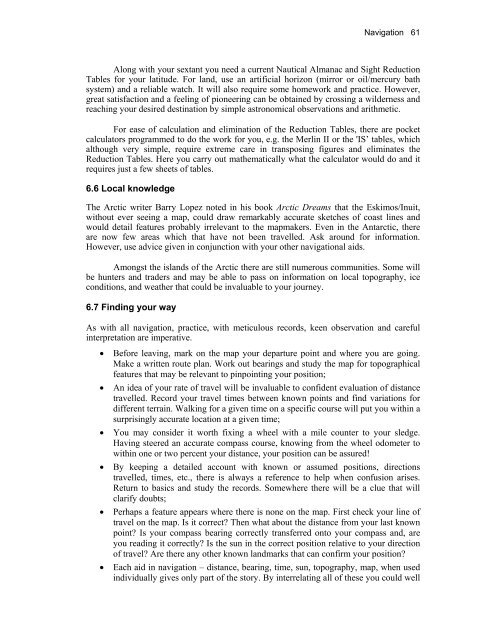Edited by Rachel Duncan 4th Edition ISBN 0-907649-91-2 London ...
Edited by Rachel Duncan 4th Edition ISBN 0-907649-91-2 London ...
Edited by Rachel Duncan 4th Edition ISBN 0-907649-91-2 London ...
You also want an ePaper? Increase the reach of your titles
YUMPU automatically turns print PDFs into web optimized ePapers that Google loves.
Navigation 61<br />
Along with your sextant you need a current Nautical Almanac and Sight Reduction<br />
Tables for your latitude. For land, use an artificial horizon (mirror or oil/mercury bath<br />
system) and a reliable watch. It will also require some homework and practice. However,<br />
great satisfaction and a feeling of pioneering can be obtained <strong>by</strong> crossing a wilderness and<br />
reaching your desired destination <strong>by</strong> simple astronomical observations and arithmetic.<br />
For ease of calculation and elimination of the Reduction Tables, there are pocket<br />
calculators programmed to do the work for you, e.g. the Merlin II or the 'IS’ tables, which<br />
although very simple, require extreme care in transposing figures and eliminates the<br />
Reduction Tables. Here you carry out mathematically what the calculator would do and it<br />
requires just a few sheets of tables.<br />
6.6 Local knowledge<br />
The Arctic writer Barry Lopez noted in his book Arctic Dreams that the Eskimos/Inuit,<br />
without ever seeing a map, could draw remarkably accurate sketches of coast lines and<br />
would detail features probably irrelevant to the mapmakers. Even in the Antarctic, there<br />
are now few areas which that have not been travelled. Ask around for information.<br />
However, use advice given in conjunction with your other navigational aids.<br />
Amongst the islands of the Arctic there are still numerous communities. Some will<br />
be hunters and traders and may be able to pass on information on local topography, ice<br />
conditions, and weather that could be invaluable to your journey.<br />
6.7 Finding your way<br />
As with all navigation, practice, with meticulous records, keen observation and careful<br />
interpretation are imperative.<br />
• Before leaving, mark on the map your departure point and where you are going.<br />
Make a written route plan. Work out bearings and study the map for topographical<br />
features that may be relevant to pinpointing your position;<br />
• An idea of your rate of travel will be invaluable to confident evaluation of distance<br />
travelled. Record your travel times between known points and find variations for<br />
different terrain. Walking for a given time on a specific course will put you within a<br />
surprisingly accurate location at a given time;<br />
• You may consider it worth fixing a wheel with a mile counter to your sledge.<br />
Having steered an accurate compass course, knowing from the wheel odometer to<br />
within one or two percent your distance, your position can be assured!<br />
• By keeping a detailed account with known or assumed positions, directions<br />
travelled, times, etc., there is always a reference to help when confusion arises.<br />
Return to basics and study the records. Somewhere there will be a clue that will<br />
clarify doubts;<br />
• Perhaps a feature appears where there is none on the map. First check your line of<br />
travel on the map. Is it correct? Then what about the distance from your last known<br />
point? Is your compass bearing correctly transferred onto your compass and, are<br />
you reading it correctly? Is the sun in the correct position relative to your direction<br />
of travel? Are there any other known landmarks that can confirm your position?<br />
• Each aid in navigation – distance, bearing, time, sun, topography, map, when used<br />
individually gives only part of the story. By interrelating all of these you could well

















